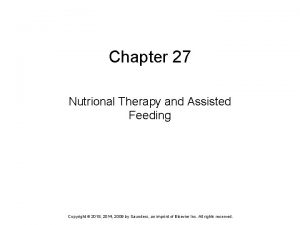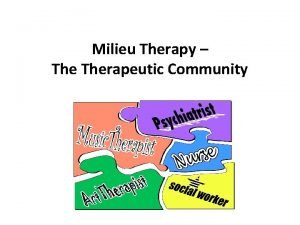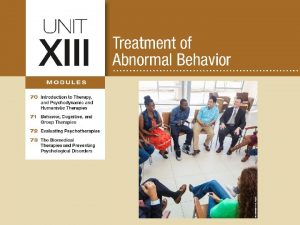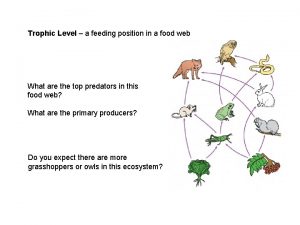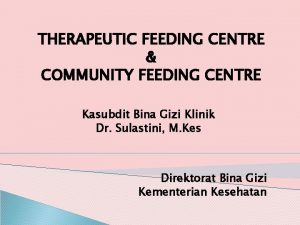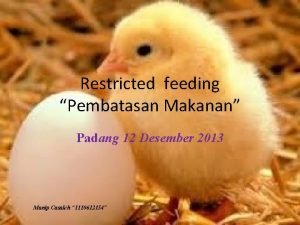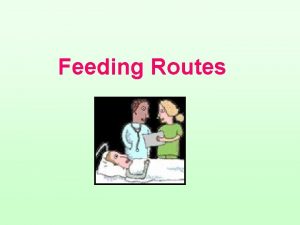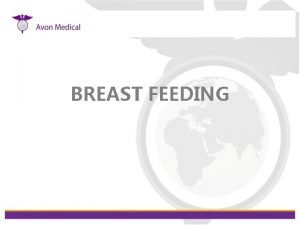INTRODUCTION TO FEEDING THERAPY WHAT IS FEEDING THERAPY










- Slides: 10

INTRODUCTION TO FEEDING THERAPY

WHAT IS FEEDING THERAPY? • Feeding disorders include problems with accessing and/or appropriately responding to food and the ability to suck, chew, or swallow it. For example, a child who cannot completely close her lips to keep food from falling out of her mouth or who gags at the sight of food may have a feeding disorder.

SIGNS AND SYMPTOMS • Difficulty coordinating breathing with eating and drinking • Refusing food or liquid • Failure to accept different textures of food (e. g. , only pureed foods or crunchy cereals) • Difficulty chewing • Coughing or gagging during meals • Recurring pneumonia or respiratory infections

INTERVENTION • Medical intervention (e. g. , medicine for reflux) • Direct feeding therapy designed to meet individual needs • SLP vs. OT vs. Registered Dietician • increasing acceptance of new foods • Oral-motor skills vs. Oral-sensory • food temperature and texture changes • postural or positioning changes (e. g. , different seating) • behavior management techniques

Aha Moment!!! We DO NOT have two oral-motor systems • Feeding and speech control systems are related. • Feeding skills are not pre-requisites to speechsound development; however, children with feeding disorders are at risk for delayed speech development and/or speech sound disorders.

Clinical experience and evidence from the work of Suzanne Evans Morris, Ph. D. supports the view that when a child experiences difficulty with oral control in feeding, there is a strong likelihood of that child having similar oral control problems in sound production and speech development.

Speech Sound Development Cooing, Babbling, Oral-exploratory play: Allows the child to practice oral-motor movement associated with sensory input and sound to support later developing speech sounds and the flexibility in movement needed for more complex sound sequencing.

Feeding Development • The infant transitions from breast or bottle feeding to spoon feeding with smooth pureed textures to finger feeding with higher textured foods (soft solids to something more crunchy but melt-able like a graham cracker. ) • As a toddler, the child begins to experiment with an increased variety of food types. Feeding development also allows the child to develop a flexible oral-motor system critical for speech sound production.

• A parallel in development occurs in the movements considered necessary for speech production and the movements that occur in the development of feeding skills. • There are many similarities between the movements that an infant would experience during feeding and those movements that are combined with sound play at a slightly later time. • Infants do not usually develop the movements in their sound play before those movements appear in feeding. • The tongue, lips, cheeks and jaw are engaged in the process of sensorimotor differentiation that sets the stage for speech EX: By 6 -9 months, when babbling emerges and reaches its heights, lip movements have been used to eliminate the loss of liquid during bottle feeding and to remove food from the spoon.

Knowing a child’s feeding history is critical when you are providing speech and language services to a child with a speech sound disorder.
 Enteral parenteral beslenme
Enteral parenteral beslenme Chapter 27 nutritional therapy and assisted feeding
Chapter 27 nutritional therapy and assisted feeding Oral placement therapy
Oral placement therapy Both psychoanalysis and humanistic therapy stress
Both psychoanalysis and humanistic therapy stress Bioness integrated therapy system occupational therapy
Bioness integrated therapy system occupational therapy What are the major humanistic therapies
What are the major humanistic therapies Role of nurse in therapeutic community
Role of nurse in therapeutic community Module 70 introduction to therapy
Module 70 introduction to therapy Feeding position in the ecosystem
Feeding position in the ecosystem Penyakit masyarakat sasaran bintibluh
Penyakit masyarakat sasaran bintibluh Restricted feeding
Restricted feeding

